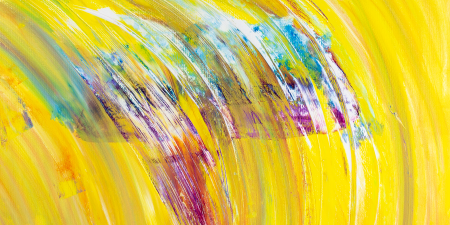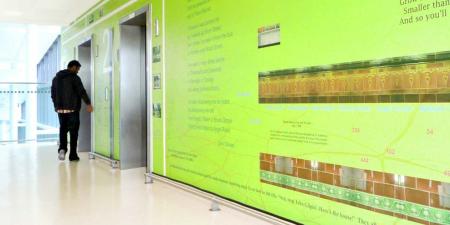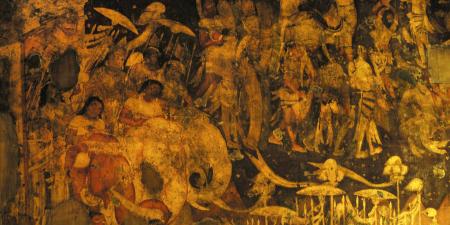Abstract
The days leading up to and waiting for the results of magnetic resonance imaging (MRI) sessions are anxiety inducing, and this anxiety has earned the moniker scanxiety. MRI images of the author’s son’s brain are used to track the progression and formation of tumors related to his neurofibromatosis (NF), a genetic disorder that occurs in 1 in 3000 births. NF can cause tumors to grow anywhere in or on the body. Analogous to pulling a print in art, the results of an MRI scan often have unexpected results. The author is an artist-researcher and mother who has painted, drawn, and pulled prints over the years about living with this disorder from a mother’s perspective. Throughout her son’s NF journey, she has found that life seems to happen “between the scans.”
Neurofibromatosis
According to the Children’s Tumor Foundation, which is the leading nonprofit organization dedicated to advancing research, knowledge, and care for the neurofibromatosis (NF) community, NF type 1 is a genetic disorder that occurs in 1 in 3000 births and can cause tumors to grow anywhere on or in the body at any time during an individual’s life.1 NF can affect the development of bones and skin and can cause learning disabilities, vascular issues, deafness, paralysis, blindness, cancer, and even death.1 My son was diagnosed with NF at 4 months old. He is currently a senior in high school and has a had a lifetime of appointments, procedures, and navigating an uncertain terrain. My son’s NF has resulted in an optic glioma, which is a tumor that develops in the cells surrounding the optic nerve. He also has 4 other brain tumors, one of which was operated on with a risk of paralysis and blindness. He has some cognitive issues, fine motor skill deficiencies, and balance and coordination issues, as well as fibromas growing on his torso and back. Needless to say, scanxiety—the anxiety induced by waiting for the results of magnetic resonance imaging (MRI) sessions—contributes to the “what next” subcurrent of daily life with NF.
Printmaking
Printmaking is a process in which an artist transfers an image onto paper using plates or blocks. As an artist-researcher, the medium beckons me to savor details, texture, quality of paper, choice of ink, and the dexterity required. Unlike painting, in which I can step back and see the results and have some sort of control over the outcome, printmaking is a bit more intimate because every nuance on the plate will also transfer to the print. Sometimes this level of detail results in an exciting outcome; at other times it can be disheartening when unseen elements on the plate get printed. There is always a sense of a mystery until the print is pulled. As much as I believe I can control how a print will look, I am often surprised at what is revealed when I pull back the paper. The unfolding of the process evokes in me an emotion akin to scanxiety: What will be revealed? Over the years, I have chosen to make prints using etching and aquatint with zinc plates. Zinc produces a rough line and holds surface well.2 I feel this rugged and durable metal is reminiscent of my son’s body—rough and durable.
Brain Surgery
When my son’s deep thalamic brain tumor had not only grown internally but also changed structurally, the NF clinic decided it was time to intervene. I trust my son’s team of clinicians and researchers. Without brain surgery, my son’s right thalamic tumor would keep growing and eventually choke off important neural pathways affecting the use of the left side of his body. With brain surgery, he might have some temporary brain damage. Temporary. What an important word. We arrived at the hospital early, and, after all the preparatory measures, my son was wheeled away from me to go into surgery. Due to his NF, my son experiences a lot of anxiety. That morning, he held my hand. At the time, I thought he needed my reassurances due to his own anxiety. I later found out he held my hand to relieve me of mine. As his mother, I tend to wear that imprint of his anxiety as well.
Hours later, we were reunited on the seventh-floor pediatric intensive care unit recovery room. My son was not awake. My husband and I had no idea what to expect. There was talk of just temporary paralysis and temporary blindness. Would any of this come true? I just stared at him, waiting for him to awaken. After what seemed like a very long time, he awoke and could see and move his extremities. I could finally exhale.
Figure 1. Uncertain Outcomes, 2020
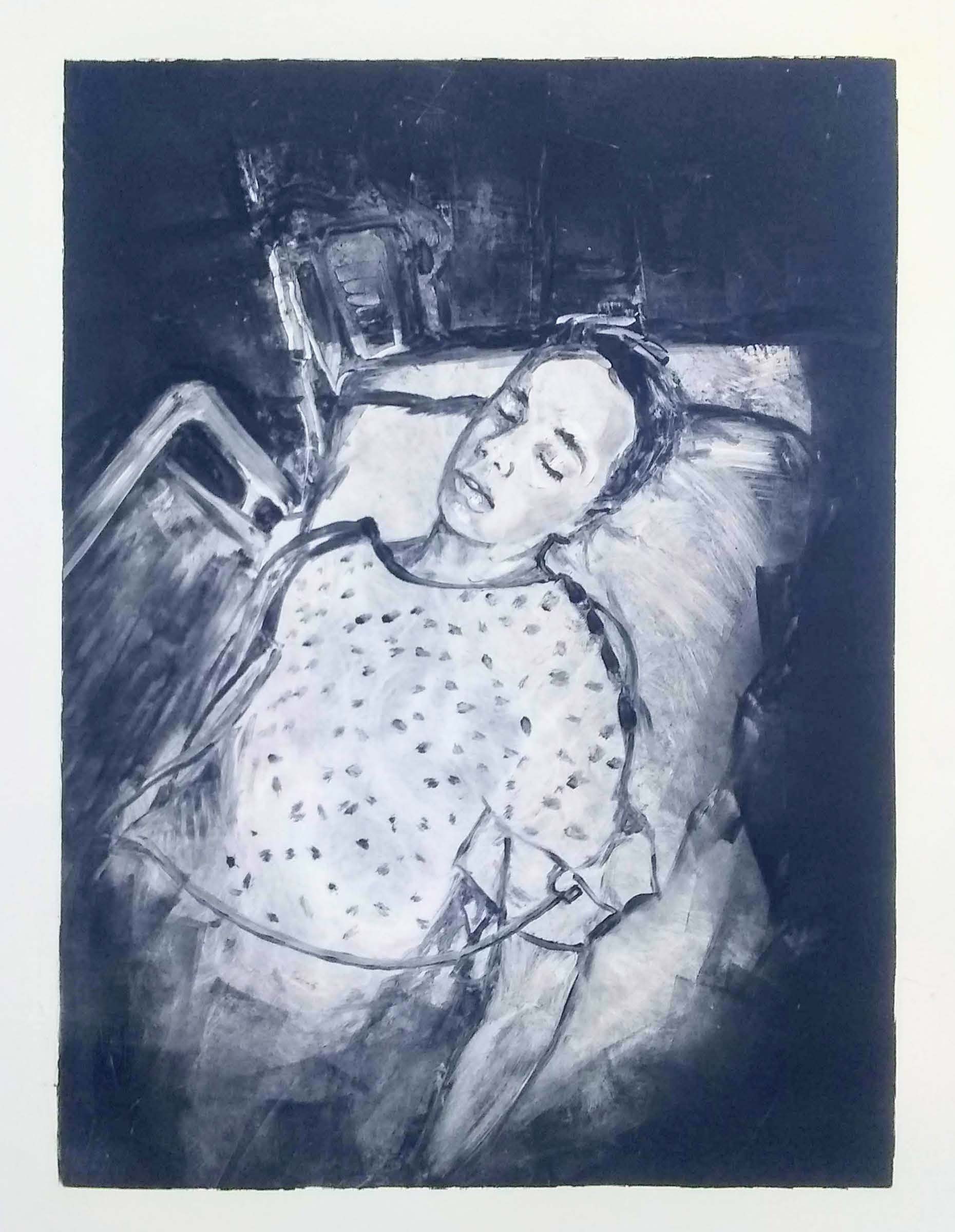
Courtesy of Rachel Mindrup.
Media
Monotype, 24" x 18".
I captured my anxiety after his brain tumor surgery by completing a monoprint, Uncertain Outcomes (see Figure 1). A monoprint is a unique process that combines printmaking and painting, resulting in a one-of-a-kind image that is developed on a flat plate with oil or water mediums and then transferred to paper.3 This type of printmaking suited me well in processing my experience as a mother. I made one print. There will be no other prints. I do not want to repeat that experience multiple times. When I look at this image, I wonder: How many other parents and caregivers look down on their child who has also had life-changing surgery and are also feeling that general mood of passivity?
Figure 2. This Can’t Be Good for me Long Term, 2021
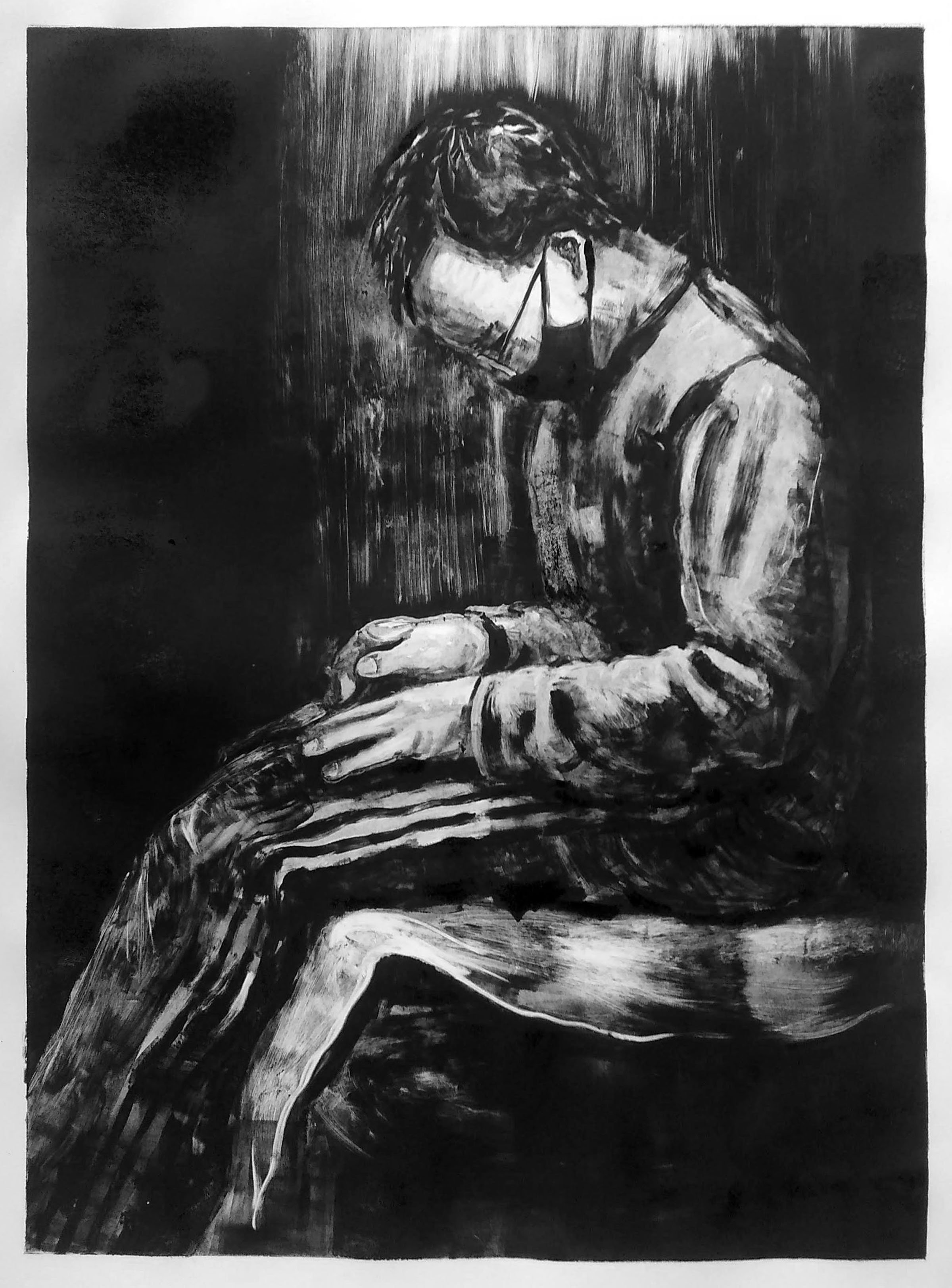
Courtesy of Rachel Mindrup.
Media
Monotype, 30" x 24".
Figure 3. This Can’t Be Good for me Long Term (Ghost Print), 2021
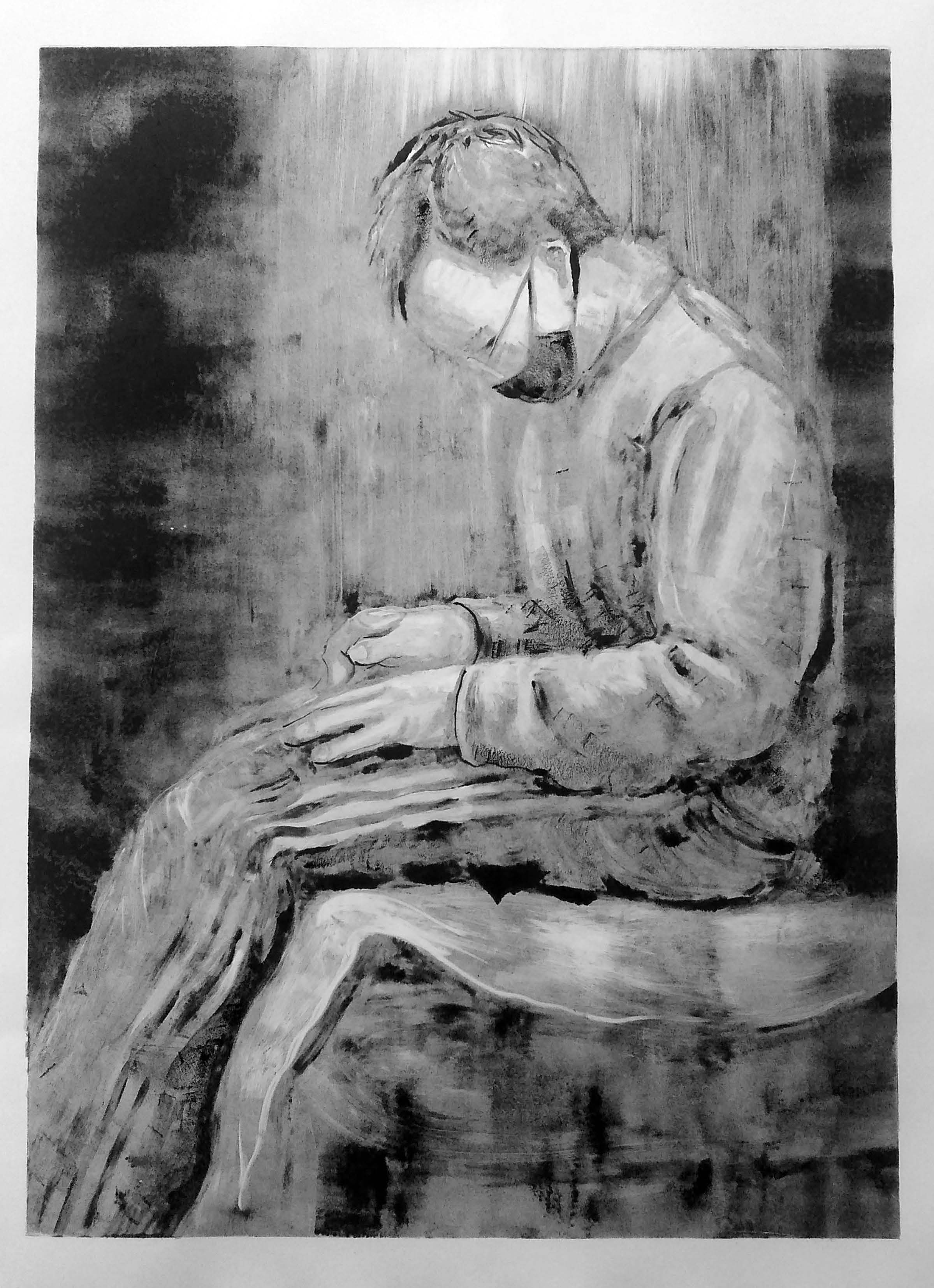
Courtesy of Rachel Mindrup.
Media
Monotype (ghost print), 30" x 24".
Scanxiety
Long before my son’s brain tumor surgery, he had been receiving brain MRI scans. These started when he was 2 years old and are scheduled for several times a year. Each time, I wait patiently yet anxiously for the results. Recently, when my son was waiting for his umpteenth MRI scan, he turned to me and said, “This can’t be good for me long term.” I didn’t know what he meant. I asked for clarification. He told me that a lifetime of brain MRIs could not be good for a person’s brain. I have no idea if there is any literature on continual MRI brain scans, but I told him that there was no alternative because NF brain tumors need to be monitored. He thought about it and said, “I’m not going to live a long full life, am I?” I was mortified and speechless. He continued, “I probably only have less than a decade left.” Moments later, the radiologist came out cheerfully. My son got up, smiled at me, and said, “It’s all good; I’m happy, Mom.” His words haunt me. Choosing the monoprint technique again, I did his portrait, hands folded in his lap, sitting on the examination table while he was waiting (see Figure 2). I also decided to run it again through the press, knowing that the resulting print would be a ghost image of the first print (see Figure 3). This fading-away image captured my fears of what the future may hold for him. It also reinforces what I know. I cannot control an unpredictable and progressive genetic disorder, but, more generally, How many of us have felt that way waiting on the examination table?
When I work on these prints, I always have nearby oil paintings of both my sons doing everyday activities. My youngest son once remarked that his friends’ mothers blogged and took social media pictures of their kids, but his mom uses art. I think because of that, the series of prints I do of my son in a medical context do not bother him or cause him undue stress. Usually, quite the opposite happens, and the artwork is a catalyst for him and me to talk about what we are feeling, often creating a stronger bond between us and usually putting me at ease.
Figure 4. Recipe for Brain Salad—Pea, 2021
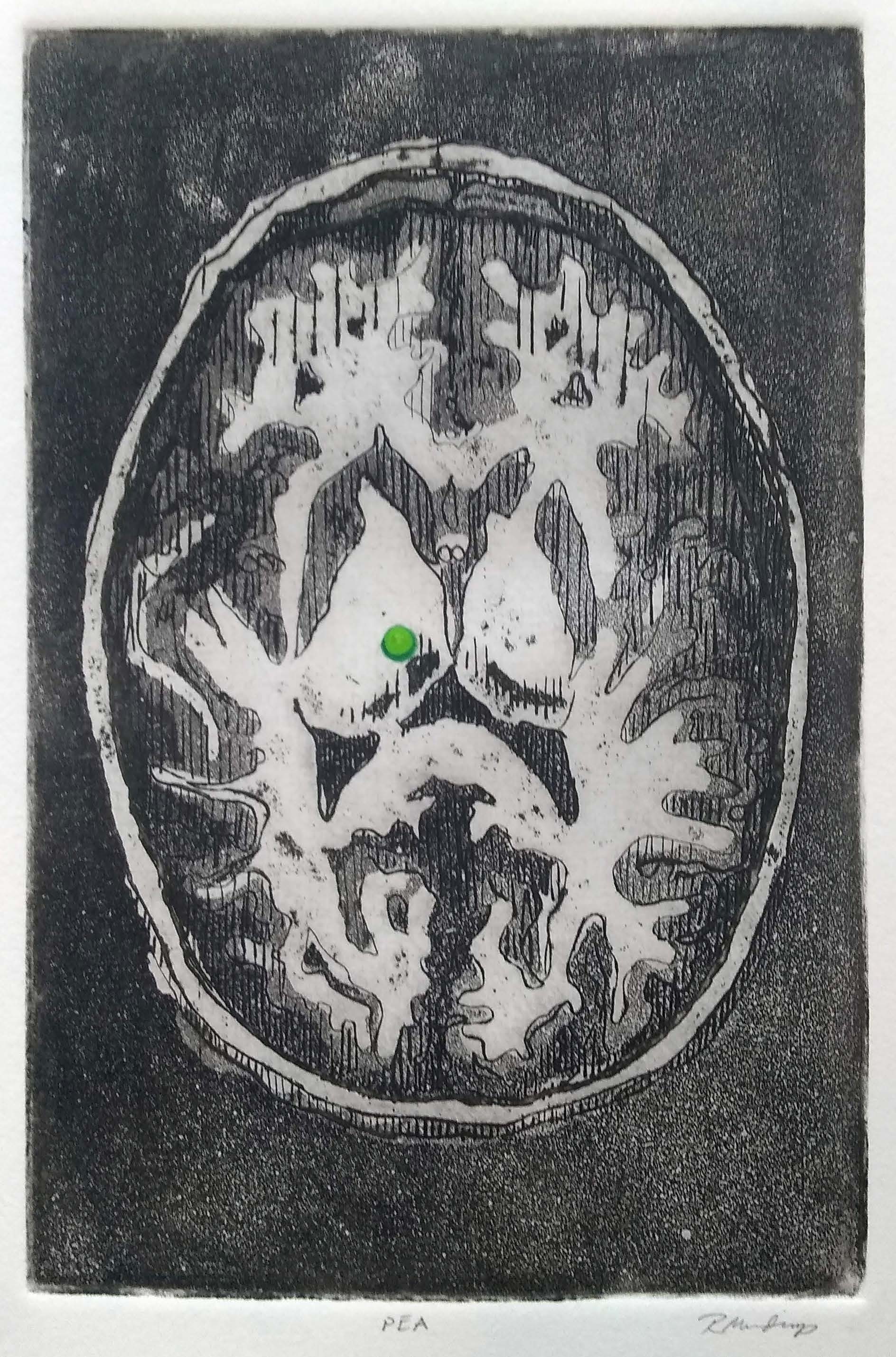
Courtesy of Rachel Mindrup.
Media
Aquatint and gouache, 9" x 6".
My scanxiety was heightened for me after my son’s startling comment. His tumors sometimes go through a food analogy metamorphosis during the in-between times of MRI scans. A tumor that starts out the size of a pea can turn into a grape, then a walnut, but evidently the size of a plum is just too big for a tumor located in the thalamus. What would have happened with the new brain tumor they discovered if he had not had thalamic tumor surgery? Would it have grown to the size of a grape, or would it have been stable? What about the other brain tumors? Would they stay stable or decide to grow into new fruits or vegetables? Using the technique of aquatint, I printed my son’s MRI brain scan to show the process of what had happened with his thalamic tumor. Unlike monoprints, etchings and aquatints are by nature made for multiples and printing editions. Printmakers will often have a limited number in their edition, so collectors know how many prints were pulled, therefore making a limited-edition series more valuable than one that is not editioned. I have chosen not to edition the brain scan series in the typical printmaking tradition because I don’t foresee an end to the scans. I wanted to alter each print with the analogy given to me by the NF team. I used gouache to paint the various nouns and verbs described to me during the growth of my son’s thalamic brain tumor. The series starts with Recipe for Brain Salad—Pea (see Figure 4) and then goes through all the phases until the surgery, which I titled Recipe for Brain Salad—Burn, as depicted in the fifth panel in Figure 5.
Figure 5. Recipe for Brain Salad—Pea, Grape, Walnut, Plum, Burn, Raisin, Raisin + Pea, 2021
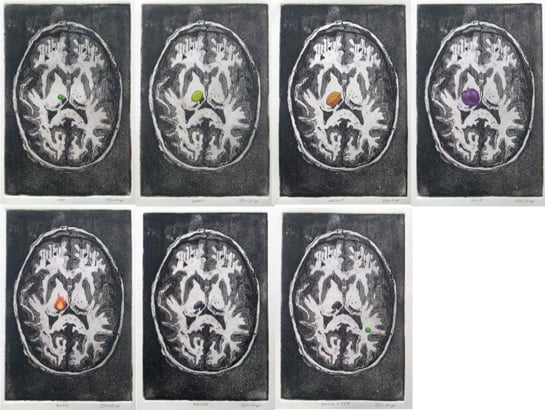
Courtesy of Rachel Mindrup.
Media
Each panel is aquatint and gouache, 9" x 6".
The last panel in Figure 5 is Recipe for Brain Salad—Raisin + Pea, because this NF brain tumor cycle will continue, with other new brain tumors developing and growing in similar ways. The prints are displayed in an unsettling way (see Figure 5), leaving a space that is empty underneath. Many viewers would want to visually complete that space by having another image there to complete the box of images, but I do not. I do not necessarily want to know the results of the next scan, but perhaps I already know what is coming. That missing image is what fuels my scanxiety.
References
-
About NF1. Children's Tumor Foundation. Accessed July 30, 2021. https://www.ctf.org/understanding-nf/nf1
-
Brooks C. Magical Secrets About Line Etching and Engraving: The Step-by-Step Art of Incised Lines. Crown Point Press; 2007.
-
Ayres J. Monotype: Mediums and Methods for Painterly Printmaking. Watson-Guptill Publications; 1991.
